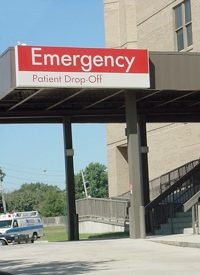
Visits to emergency rooms for drug- and alcohol-related incidents climbed from about 1.6 million in 2005 to nearly 2 million in 2008, according to the federal Substance Abuse and Mental Health Services Administration. From 2006 to 2008, the number of those visits resulting in violence jumped from 16,277 to 21,406, the agency said. University of Cincinnati professor Donna Graves, who is helping the federal government study solutions, notes, “What has heightened fears among nurses and other health professionals is that attacks have become more violent. What’s bringing attention to it now is the type of violence: the increase in guns, in weapons coming in, in drugs, the many psychiatric patients, the alcohol, the people with dementia.” The AP has reported several cases of ER nurses being assaulted by patients, and one woman being groped. In 2007 a male nurse in Seattle was smashed in the face with a club by a junkie who had entered the ER in search of a fix. The same nurse was attacked a second time this year when a patient punched him, then threatened to come back and kill him. He’s pursuing felony charges.
Many nurses have responded to the escalating ER violence by seeking tougher criminal penalties. One nurse in New York pressed charges against a patient after the 250-pound teenager dislocated her jaw. "It’s come to the point where nurses are saying, ‘Enough is enough.’ The slapping, screaming and groping are not part of the job," says Joseph Bellino, president of the International Association for Healthcare Security and Safety. He notes that nurses as well as experts in mental health and addiction report that patient frustrations have caused the violence to steadily worsen since the downturn in the economy, as cash-strapped states close state hospitals, cut mental health jobs, eliminate addiction programs and curtail other services. Robert Glover, executive director of the National Association of State Mental Health Program Directors, agrees that recessions are the worst time to cut mental health programs, because anxieties about lost jobs and lack of insurance increase drug and alcohol use — resulting in family fights. "Most of [these people], he observes, if it’s a crisis, will end up in the emergency room."
Glover further noted that the "entitlement" or "immediate gratification" mindset of many Americans also exacerbates the problem. "They want to be able to pop in and get what they need immediately, when the emergency department has to see the sickest people first." David DeRosia, a Vermont nurse who has been attacked at work, concurs: "There are many people who have unrealistic expectations they can get whatever they want [at an ER] immediately, and it’s not a reality."
Embattled nurses have begun to push for uniformed police in the ER, as well other measures recommended by the American College of Emergency Physicians, such as 24-hour security guards, bulletproof glass, and panic buttons for staff. Henry Ford Hospital in Detroit is among those that have found success in the use of metal detectors — having confiscated 33 handguns, 1324 knives and 97 Mace sprays in just the first six months of the program. Joseph Bellino notes that safety for ER personnel should begin with teaching them to recognize the signs of violence and thus defuse volatile situations. He recommends that nurses, doctors, administrators and security guards have a plan for working together when violence erupts. "In my opinion," he observes, "every place we’ve put teamwork in, we’ve been able to de-escalate the violence and keep the staff safer."
Though bills making an assault on a nurse a felony instead of a misdemeanor have just failed in both North Carolina and Vermont — with Virginia shunting a similar proposal to a state crime commission — 26 states have applied tougher penalties for assaults against on-the-job healthcare workers.




